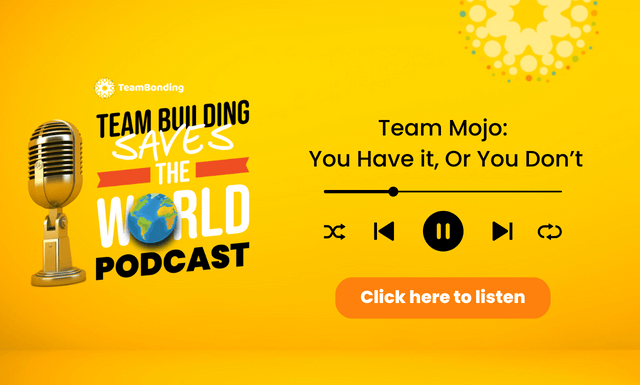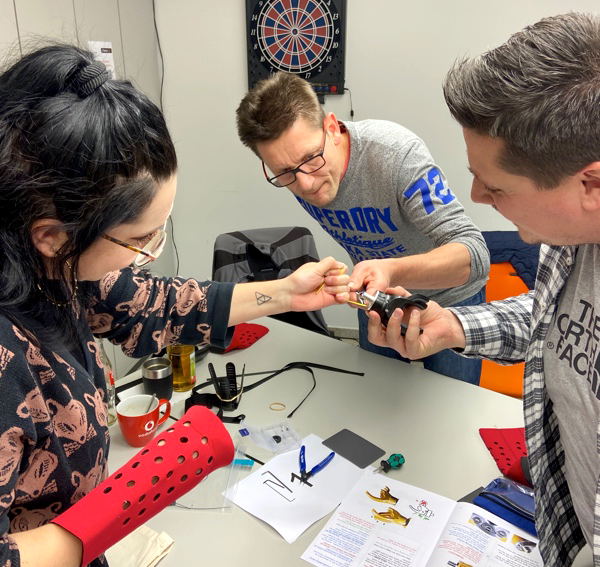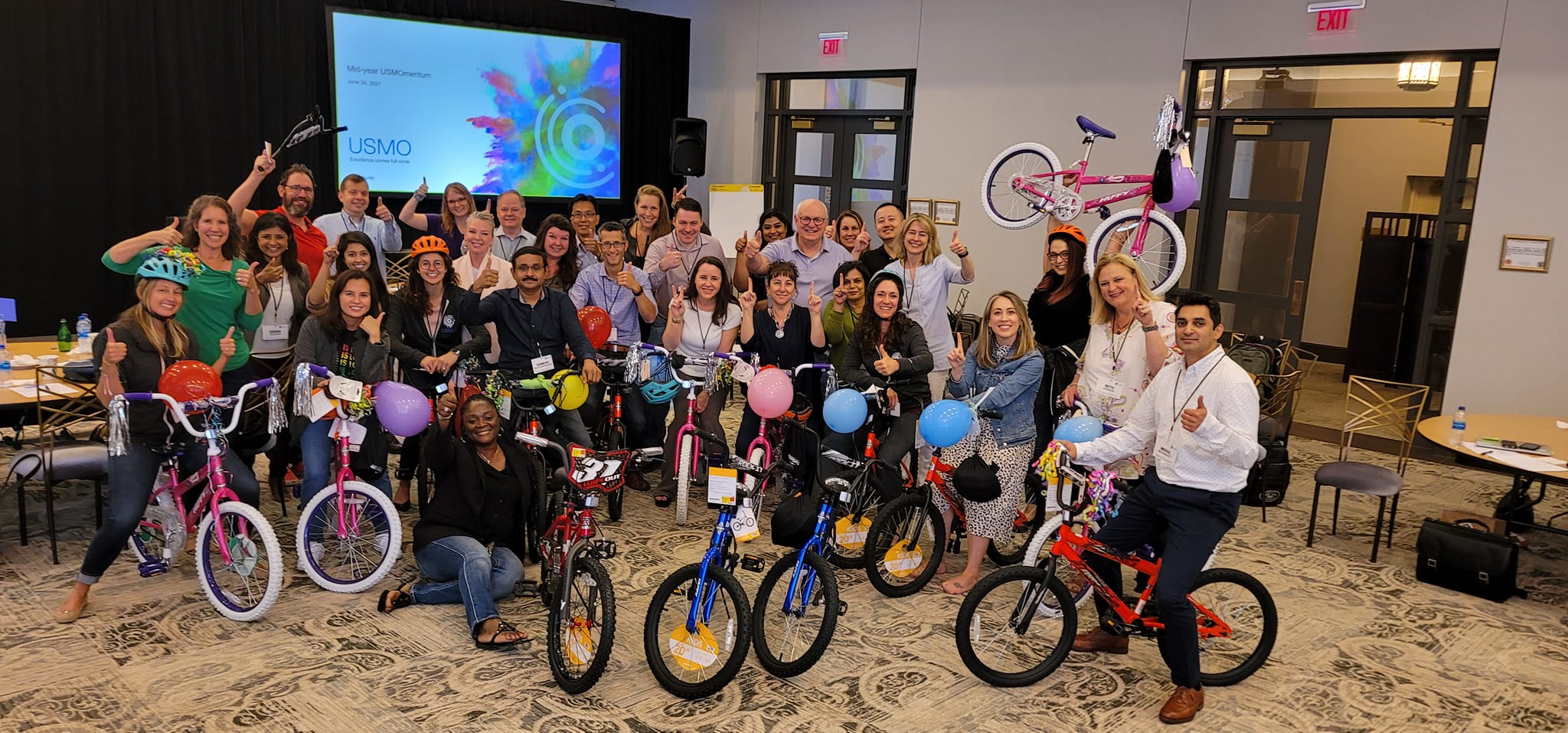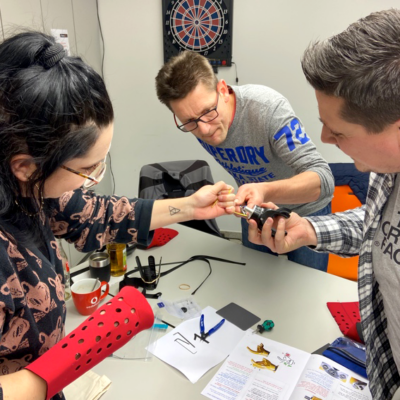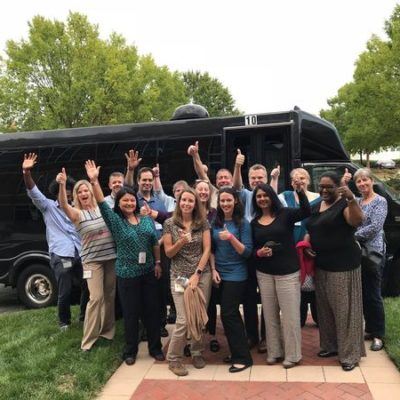Group synergy is one of those buzz phrases that gets tossed around a lot, but what does it actually mean? Group synergy is the art of harnessing the collective strength of a group of individuals to achieve more than what could be accomplished individually. If you can understand and harness the power of team synergy, you and your team can reach new heights.
In our Team Building Saves the World podcast, Team Mojo: You Have it, or You Don’t, we talked to Diane Egbers—Founder and CEO of Leadership Excelleration—about corporate synergy, its importance, and how to build it. On the topic, Egbers said:
“What we want to do is help people to see that it takes all types of people to get optimal results. We have kind of one way of looking at the world based on our strengths, style, and genius. But there are lots of other ways to look at it, and we embrace that and welcome that.”
In today’s blog, we’re going to take a closer look at group synergy. We’ll cover what it is, why it’s important, how to build it, and how to overcome some of the most common challenges.
The Foundation of Group Synergy
To start, let’s look at the foundation of group synergy. There are a few important things you need if you want to get the benefits of corporate synergy, so let’s look at each of them. When it comes to how to create synergy in a group, having a good team is step one.
A Synergistic Group
If you want group synergy, you need a strong team of employees. A well-rounded and cohesive group is an essential part of employee synergy. When it comes to how to create synergy in a group, having a good group of employees is step one.
Admittedly though, that’s pretty vague. What exactly does having a synergistic group mean? How do you build a synergistic group?
It all starts at the beginning—recruitment and selection. When you’re putting a team together, you have the ability to choose your players so to speak. Just like a draft in sports, you want to choose the best possible people for your business.
That said, there’s more to putting a team together than talent. You also need to be considering strengths and weaknesses, personality, how they’ll fit with the rest of the company, etc. Remember that you’re hiring a group member, not a singular person who will work on their own separate from everyone else.
From there, the next thing is onboarding and training. Choosing great employees is a good first step, but you need to prepare them for their role in the group. Employees need to be welcomed into the company, provided with ample information and context, and given the necessary training.
For many companies, this includes training and programs. An employee wellbeing initiative can help employees feel more comfortable at work, and specific job training can help them better the skills needed for their role.
Defined Roles and Responsibilities
The next foundational element you need are defined roles and responsibilities. This might be obvious, but ensuring everyone knows what they need to do often gets overlooked. However, it is absolutely essential to creating employee synergy.
Thankfully, this is a relatively simple step. The key is being able to communicate effectively. That means managers and leaders being able to communicate with employees, as well as employees being able to communicate with themselves and their leaders.
Make sure people can have their voices heard, and listen to what they have to say. Create an environment where communication is common and expected.
From there, you just need to ensure the proper channels and information are in place so everyone knows their responsibilities. No one should be asking, “is this my job” or “what’s this task for?” Everyone should know exactly what their role is, what their responsibilities are, and how to complete them.
A Common Vision
The last foundational element you need is a common vision. A common vision is what unites your group, gives them purpose, and gives them direction. Without a common vision, achieving employee synergy is near impossible.
Again, this is relatively simple. First, you need clear goals. We recommend using the SMART goals method, as it helps you create goals that are achievable and measurable. And once you have clear goals, you need to make sure they are communicated to your teams effectively.
Your goals also need to tie into your mission statement(s) and objective(s). Every company needs a purpose, and that helps people understand the company’s importance and their role in the company.
With a clear mission statement, objectives, and goals, you can effectively unite your group around a common cause and find the synergistic group you’ve been looking for.
The Key Elements of Employee Synergy
Now, let’s look at some of the key elements of corporate synergy. If you want to know how to build synergy while working with a team, you’ll need these elements.
One of the first things you need is something we mentioned already—communication. It’s hard to overstate the importance of effective communication when it comes to group synergy. You and your team need to be able to communicate clearly and effectively if you want to work together at your best.
Another necessary element for knowing how to create synergy in a group is trust and collaboration. To work together effectively, you need to trust each other. You need to trust your coworker can do their part so you can focus on yours.
And when necessary, you have to be able to collaborate too. When people work together, they can become more than the sum of their parts. So your employees need to be able to communicate and work together.
Besides all that, you also need a group that is diverse with complementary skills. Everyone is different, but they all have something unique to bring to the table. You want everyone on your team to offer something different, ultimately creating a synergistic group.
Egbers mentioned this during our discussion, highlighting the importance of group members being their authentic selves. She said, “We really need to nurture both relationships and results; we want to have sustainable performance, and people really have to be able to bring their whole authentic selves to the work.”
Strategies for Building Corporate Synergy
With all the background covered, let’s talk about strategies. If you want to know how to build group synergy, you need to know some effective methods to do so. And don’t worry—we’ve got some great strategies that will help you better your teams.
At risk of sounding like a broken record, one of the simplest and most straightforward strategies for building employee synergy is effective communication. Things like regular meetings and check-ins can have a big impact on your group synergy. It may seem basic, but putting an emphasis on communication can have surprisingly impactful results.
Another strategy is to invest in your team. To start, investing in your employees shows to them that you care, which can have a big impact on their motivation and satisfaction at work. Beyond that though, it’s essential if you want to keep growing and improving as a group. This is something that Egbers highlighted in our conversation.
“We need leaders to understand that it requires an investment in the group,” Egbers stated. “You can’t just keep pushing for results and think that relationships will manage and cultivate on their own.”
Things like workshops and team building exercises can help you develop relationships, build connections, and better crucial skills. For example, our Prosthetic Hand Project can help your employees get a new perspective on life, work together, and grow relationships—all of which can help build synergy.
Challenges to Achieving Group Synergy in the Workplace
As we near the end of today’s article, let’s quickly go over some of the common challenges of achieving group synergy. Achieving employee synergy is doable, but there are some obstacles you may need to overcome.
Lack of communication is arguably the biggest obstacle to synergy. If you and your team cannot communicate effectively, synergy won’t be possible. To avoid this, put an emphasis on communication. As mentioned earlier, have regular check-ins, make sure people have their voices heard, and actively listen instead of waiting for a chance to respond.
Another common obstacle is conflicting personalities. This is a harder issue to address, as the solution can vary greatly depending on your teammates.
For example, some personality issues can be sorted out simply by sitting down and talking it out. On the other hand, some personality issues go a lot deeper. Those issues may require reassignments or more to deal with.
Your knowledge of your group and discretion is key. If you know your employees well, you should be able to figure out the best way to deal with personal conflicts. Just make sure you keep your team and their wellbeing in mind.
Lastly, sometimes groups just lose their synergy. This isn’t uncommon, as the workplace is always changing. Talking about how teams lose their “mojo,” Egbers said:
“It can be two or three group members changing, and there’s a shift in the culture that a team needs to account for. Sometimes there’s a dramatic change in the external shift of business in the marketplace and an organization needs to pivot quickly.”
At the end of the day, you just need to be aware of what’s going on. If group members change, keep a close eye on the new members and see if anything needs to be addressed. If there are market factors at play, address them as necessary too. Staying on top of changes will make sustaining synergy easier.
Build Synergy in the Workplace with TeamBonding
Synergy is your group’s ability to come together as a whole and create something greater than any of the individual parts. It can help you and your employees reach new heights, achieve goals, and be the best team possible. And with the strategies in this guide, you should be able to create employee synergy.
Build synergy with TeamBonding. We covered the topic of synergy in-depth on our latest podcast, and we have over 25+ years of experience putting on corporate events. We have a wide variety of events that can help you build a synergistic group. So get in touch with us today and start building a stronger team.
